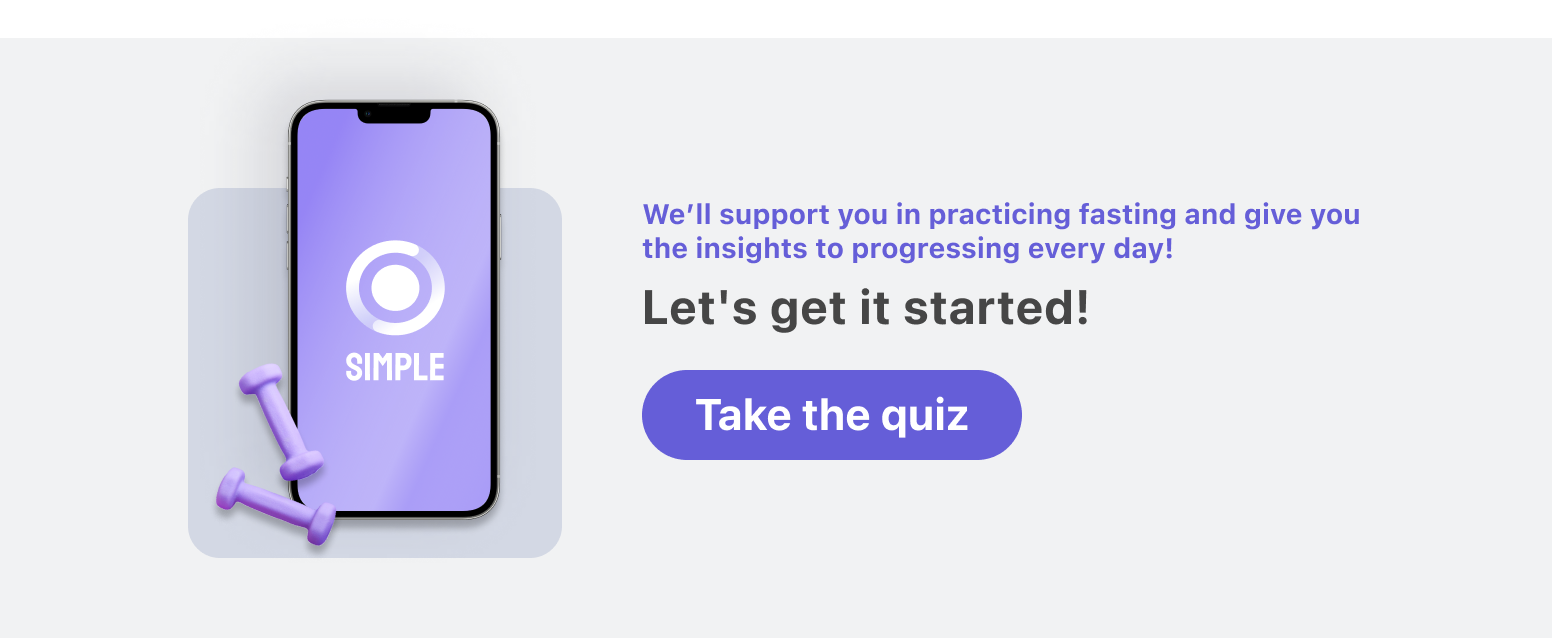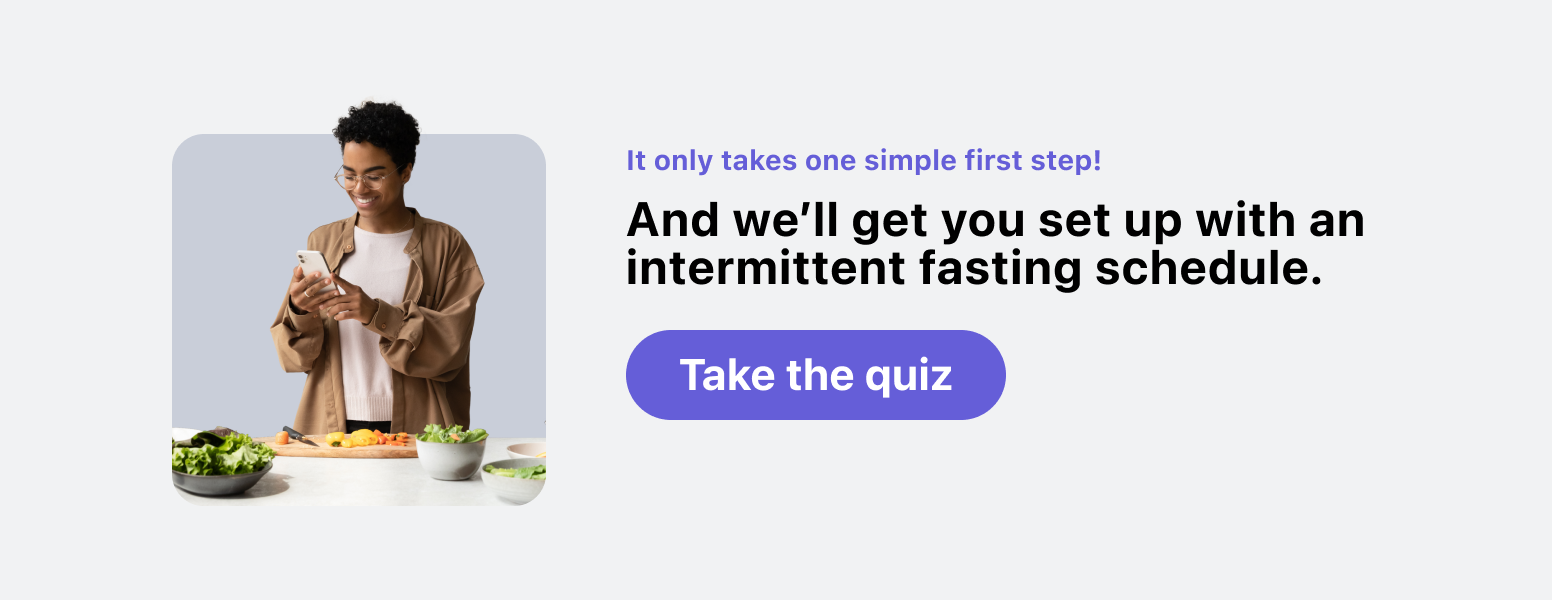Low-carb diet and intermittent fasting

You’ve tried low carb. You’ve tried intermittent fasting. But what might happen if you tried them … together?
Low-carb intermittent fasting. Is it madness? Or is it genius?

Let’s take a look.
What is a low-carb diet?
A low-carb diet is pretty much what it sounds like:
A diet that limits the amount of carbohydrates you eat.
There are three main kinds:
- modified carb (<180 g of carbohydrates per day)
- low carb (<130 g / day)
- very-low-carb, aka ketogenic (<50 g / day)
If you want to go low carb, we recommend getting between 50 and 130 g of carbs into your diet each day. Very-low-carb — aka a ketogenic diet — isn’t an option we’d encourage you to try without talking to your healthcare provider first.
Here’s the most important take-home point: low carb doesn’t mean no carb. It means adjusting the type of carbohydrates in your diet by choosing
- more slower-digesting, higher-fiber whole food options, including fruits, vegetables, whole grains, and beans / legumes; adnd
- fewer highly processed carbs such as white bread, pastries, sweetened drinks, and so on.
We explain all of this more in our guide on low-carb diet plans (or just read on!)
Is combining a low-carb diet and intermittent fasting a good idea?

Combining a low-carb diet and intermittent fasting seems to make a lot of sense.
Both are geared toward weight loss.[1] Both can help reduce overall blood sugar levels.[1] Both stimulate fat burning. There are a lot of synergies between the two (we’ll dig more into those later).
That said, both have their challenges. They can come with hunger and cravings (although this can be managed with smart food choices). They each require you to change how you currently eat. And so on.
So:
- On the one hand, you may get better results by pairing intermittent fasting and a low-carb diet.
- On the other hand, you may have to work harder to overcome the obstacles and make this double lifestyle change stick.
What should you expect from this process?
If you mix intermittent fasting with a low-carb lifestyle, you’ll likely notice:
- lower blood sugar
- ketosis
- weight loss
All three of these go hand in hand. Here’s why.
When you fast, you have periods when there’s no food coming in. Equally, when you eat a low-carb diet, you’re eating fewer carbohydrates. Both of these situations mean there’s less food for your body to turn into glucose. This means lower blood sugar levels, and less circulating insulin (the hormone that’s released to get blood sugar to where it needs to go).
When your blood sugar is low enough, your body has to use your stored glucose (aka glycogen) in your liver for energy. Once that’s used up, your body prefers to use the next energy source: stored fat. This switch from using glucose to using fat for energy is called ketosis,[2] and it’s stimulated by both fasting and not having enough carbohydrates available to use for fuel.
A low-carb diet can mean less stored carbohydrates are available, so when you fast, you get into ketosis more quickly. (Again, a ketogenic diet — where you’re in ketosis even when food is coming in — is a very low-carb diet, with carbs well under 50 g / day.)
Thus, by burning your stored fat — as well as (hopefully) creating a calorie deficit through fasting and eating low carb — you lose weight.
Does a low-carb diet boost intermittent fasting results?
A low-carb diet can boost intermittent fasting results because, as we’ve seen, they produce results by similar mechanisms. (This is especially the case for people with obesity and type 2 diabetes.[3])
So, if you follow an intermittent fasting schedule in order to lose weight, following a low-carb meal plan can help by getting you into ketosis faster and for longer — again, because there’s likely to be less stored carbohydrates available.
If you’re doing intermittent fasting to help you manage your blood sugar and protect against type 2 diabetes, again, eating low carb can support that by encouraging food choices during your eating window that support stable blood sugar levels.
What are the benefits of going low carb on an intermittent fasting schedule?
Apart from the possibility of enhanced results, as we’ve already seen, going low carb on an intermittent fasting schedule can be beneficial in other ways, too.
Reducing appetite
For instance, some studies show that a low-carb diet could reduce your appetite and help you manage hunger better,[4] possibly due to eating more protein and fiber, both of which help you feel fuller for longer.
That, in turn, can help you fast more comfortably. So not only do you get the most from your fasting because it’s easier to sustain, the experience is less of a struggle. Fewer hunger pangs = happy days! (And less hunger-driven “bear with a sore head” energy at home and work.)
Making wiser food choices
In addition, shifting to less-processed, slower-digesting, higher-fiber carbs — along with lean proteins and healthy fats — is a healthy choice regardless.
More healthy foods and fewer processed foods sounds like a win overall! Your blood triglyceride levels will likely thank you, perhaps leading to lower cholesterol [5] and potentially less risk of cardiovascular disease, especially if you are living with obesity or carry extra weight. Maybe your inflammation levels drop too,[6] meaning less painful joints or a reduced risk of chronic conditions (for many chronic diseases, inflammation is a key risk factor). The hits keep coming: intermittent fasting may boost both of these.
Sound good? If you’re eager to give this powerful combo a try, take our Simple quiz to get started on your journey!
What to eat while low-carb intermittent fasting

Let’s look at what a low-carb intermittent fasting meal plan includes.
Your daily meals and snacks would be a mix of foods like:
- fish and seafood, like salmon, shrimp, and cod
- meat, like beef, pork, lamb, game, and poultry
- eggs
- tofu and tempeh
- nuts and seeds
- dairy products, like butter, sour cream, yogurt, and cheese
- natural fats, like coconut oil and olive oil
- lettuce and other leafy greens, like spinach and kale
- non-starchy vegetables, like asparagus, bok choy, broccoli, Brussels sprouts, cabbage, cauliflower, cucumbers, eggplant, mushrooms, tomatoes, and zucchini
In a nutshell, a low-carb meal plan includes lots of high-protein, high-fiber, high-healthy-fat, whole foods.
That’s because when you’re reducing your carb intake, increasing protein and fiber helps a lot with feeling full and satisfied and helps keep hunger and cravings under control. This is essential for making low carb a sustainable, long-term way of eating.
As luck would have it (it’s actually more science than luck, but still, it’s a good thing), these are the kinds of foods that pair beautifully with intermittent fasting. Have a read of our what to eat during intermittent fasting guide, and you’ll notice a ton of crossover.
What NOT to eat while low-carb intermittent fasting
Let’s think about which foods don’t feature as much in a low-carb intermittent fasting diet plan. As you’d expect, these are foods that are full of simple sugars, but this list also includes more complex carbohydrates.
Nutritious, but eat smaller portions:
- starchy tubers like potatoes, sweet potatoes, yuca, taro, etc.
- rice, beans, and lentils
- whole grains and whole grain products
- fruit
None of these foods are “bad,” and they’re not “forbidden” — in fact, they’re wonderfully nutrient-dense. They’ll just eat up your carb allowance pretty fast if you’re not mindful of them.
Definitely consider cutting down on the following:
- full-sugar soda and juice
- candy, chocolate, cake, and ice cream
- processed breakfast cereals, pasta, and crackers
- wine, beer, and other alcoholic drinks
These foods aren’t “forbidden” either, but they are lower in nutrients. So, when you choose carbs to include in your low-carb diet plan, choose the nutrition-rich, whole-food options for best results. They’ll help you lose weight, improve your health, and manage your appetite.
(Making a little space for less-optimal choices, like a cookie here and there, is important too.)
Low-carb friendly drinks
Let’s not forget drinks here — what are your low-carb-diet-friendly drink options?
Again, there’s some solid crossover with what you can drink while fasting because most drinks with calories have carb calories (think lattes, full-sugar sodas, fruit juice, etc.). Low-carb beverages include tea and coffee without milk or sugar, diet sodas (a couple per fast are fine), and all kinds of water (sparkling, still, with a little lemon, etc.).
There are a couple of drinks that get the OK for low carb but not for fasting, like bulletproof coffee and bone broth. If you enjoy that kind of thing, keep it for your eating window, and you’re all set!

Common side effects of low-carb intermittent fasting
The early stages of both a low-carb diet and intermittent fasting come with side effects, but don’t worry too much. In the first couple of weeks, you may experience:
- bad breath
- constipation
- fatigue
- diarrhea
- hair loss
- difficulty falling asleep
- irritability
Ride these out, and your body will likely settle into the groove and shake them off. You won’t have bad breath forever! (Your partner and co-workers can breathe easy … as can you!). However, if they do continue or start to worry you, speak with your doctor.
Pay attention to how your body feels, and make adjustments as you go along. You might feel better with a little more carbohydrates in your system, especially if you’re active.
Who can go on a low-carb intermittent fasting diet?

So, who are the people who are safe to follow a low-carb diet with intermittent fasting? Most people are good to go, but there are increased risks for some people.
Consult a doctor first if you:
- take prescription medications
- have a medical condition
- are under 18 or 80 years or older
- have a body mass index (BMI) <18.5
- are extremely active
- have (or are at risk of having) an eating disorder or have a history of one
- are pregnant, breastfeeding, or trying to conceive
If it’s safe for you to try these approaches to eating, check out our guide on intermittent fasting for beginners to help you get acquainted with the different schedules.
Then, take our Simple quiz to get started with one, and we’ll support you in practicing fasting, help you track your food intake, and give you the insights to keep you on track and progressing every day!
How to go on a low-carb intermittent fasting diet safely
Changing how and what you eat is a process. To be safe, go steady and give your body time to adjust.
Start with small changes
Slowly start to decrease your carbs and increase your protein, veggies, and healthy fats.
Cut a slice of toast from your breakfast and replace it with an extra egg. Thin out your portion of rice at dinner and replace it with a little more chicken or fish. It’s way easier to go slow and steady, one meal at a time, than to make a full-scale overhaul of your entire diet in a single day.
Use a macro tracker
It’s tricky to gauge how many carbs, protein, and fat grams you’re eating without quality data. While you’re getting into the swing of things here, use a macro calculator to keep tabs on what you’re eating so you can learn what 50–130 grams of carbs looks and feels like without inadvertently dropping into the very-low-carb zone.
Listen to your body
Your body will clue you into your needs, so notice how you feel as you introduce low-carb eating and intermittent fasting into your life. What results do you observe? Are the side effects clearing or sticking around? How’s your energy? How are you sleeping?
As a rule of thumb, once you’ve adapted to this way of eating, you should feel good: energized, alert, sleeping well, stable moods, manageable hunger, etc. If things feel off — and persist in feeling off — try shortening your fasts and/or increasing your carbs to see how it helps.

How much weight you can lose with low carb and intermittent fasting will depend on lots of factors, like how active you are, your age, which intermittent fasting schedule you choose, any medical conditions, and so on. So it’s hard (and not super useful) to make a prediction.
What we can say is that a safe and sustainable rate of weight loss is around 1 to 2 lbs per week, and that’s pretty achievable for most people.
There are lots of reasons why you might not be losing weight on low carb and intermittent fasting. We cover a ton of them in this article about why intermittent fasting might not be working for you. (Plus, a bunch of strategies to change that.)
It might also be that you’re falling into some classic intermittent fasting mistakes, so check those out too!
A 16-hour fast could put you into ketosis for sure![7] Research shows it’s more likely with a longer fast than a shorter one, but the timing will vary from person to person. If you’re safe to give 16:8 intermittent fasting a go, try it out and see what results you get (give it a month or so to really see the potential).
You don’t need to count either calories or carbs while intermittent fasting! The fasting period is there to cut calories for you — the idea being that if you eat for fewer hours per day, you’ll naturally eat less.
If you want to combine a low-carb diet with intermittent fasting, then you’ll need to count your carb grams to make sure you’re within the 50–130 g range.
Dirty fasting is a type of time-restricted eating — like 12:12 or 18:16 — that allows you to consume about 100 calories during the fasting window.
At Simple, we don’t subscribe to the concepts of either “clean” or “dirty” fasting because these words carry associations — of “cheating,” “permission,” or “guilt,” for instance — that aren’t helpful.
We’d simply consider eating more than 10 calories within your fasting window as breaking your fast and therefore interrupting the benefits of the fasting process. It’s not good or bad or wrong or right; it’s just a biological fact.
“Does intermittent fasting slow metabolism?” is a question we hear often. The short answer is that it doesn’t seem to. For the long answer, check out the link!

- Moon S, Kang J, Kim SH, Chung HS, Kim YJ, Yu JM, et al. Beneficial Effects of Time-Restricted Eating on Metabolic Diseases: A Systemic Review and Meta-Analysis. Nutrients [Internet]. 2020 Apr 29;12(5).
- Paoli A, Rubini A, Volek JS, Grimaldi KA. Beyond weight loss: a review of the therapeutic uses of very-low-carbohydrate (ketogenic) diets. Eur J Clin Nutr. 2013 Aug;67(8):789–96.
- Choi JH, Cho YJ, Kim HJ, Ko SH, Chon S, Kang JH, et al. Effect of carbohydrate-restricted diets and intermittent fasting on obesity, type 2 diabetes mellitus, and hypertension management: consensus statement of the Korean Society for the Study of obesity, Korean Diabetes Association, and Korean Society of Hypertension. Clin Hypertens. 2022 Jun 1;28(1):26.
- Hu T, Yao L, Reynolds K, Niu T, Li S, Whelton P, et al. The effects of a low-carbohydrate diet on appetite: A randomized controlled trial. Nutr Metab Cardiovasc Dis. 2016 Jun;26(6):476–88.
- Gjuladin-Hellon T, Davies IG, Penson P, Amiri Baghbadorani R. Effects of carbohydrate-restricted diets on low-density lipoprotein cholesterol levels in overweight and obese adults: a systematic review and meta-analysis. Nutr Rev. 2019 Mar 1;77(3):161–80.
- Ciaffi J, Mitselman D, Mancarella L, Brusi V, Lisi L, Ruscitti P, et al. The Effect of Ketogenic Diet on Inflammatory Arthritis and Cardiovascular Health in Rheumatic Conditions: A Mini Review. Front Med. 2021 Dec 14;8:792846.
- Mattson MP, Longo VD, Harvie M. Impact of intermittent fasting on health and disease processes. Ageing Res Rev. 2017 Oct;39:46–58.
